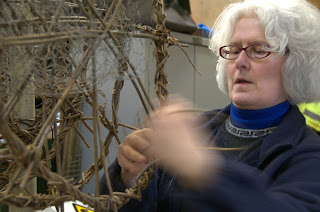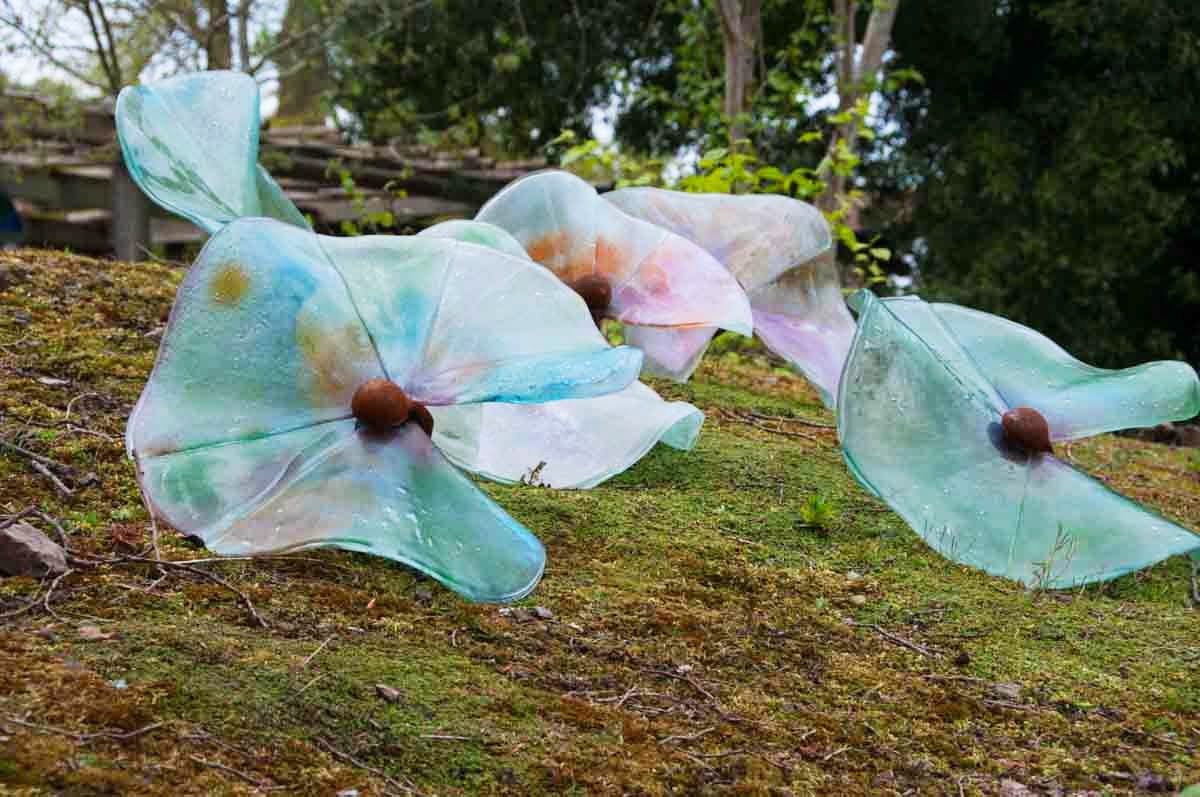Last week I met Ethel. I’m not sure what image that name conjures up for you – perhaps it is the gutsy singer Ethel Merman or the eccentric EastEnders character Ethel Skinner. For me, I immediately think of Lucille Ball’s sidekick character Ethel Mertz in the old American sitcom I Love Lucy. It seems that Ethel is one of those names that summons a big personality, and the Botanic Garden’s Ethel is no exception. Of course, this might be due in part to her impressive stature at nearly 8 feet in height.
Ethel is a new willow sculpture currently under construction at the Botanic Garden. She is the first of two moa birds that will be on display among the native New Zealand plants in the garden. Despite her towering height, Ethel is going to be the smaller of the two birds, with the other giant expected to stand closer to 12 feet tall. The sculpture was named by her creator, Sally Meadows, who has been working two days a week on the ambitious project since February.
“Ethel had to be a female,” explains Sally, “because the female moas were much bigger than the males. It’s one of the biggest size differences known among bird species.”
 |
Ethel is the first of two moa bird willow sculptures to
be displayed at the Botanic Garden later this year. |
The plight of the moa
Moas are an extinct group of flightless birds that were endemic to New Zealand until they were driven to extinction. There were nine species all together, and the largest of the species, Dinornis robustus and Dinornis novaezelandiae, could reach heights of 12 ft and are estimated to have weighed around 500 lb.
Artist renditions of the birds look very similar to an emu, with feathers that have evolved to look more like fur, broad feet and sturdy legs built for running, and a long neck for browsing foliage. While originally it was thought that moas stood with very upright necks, much like emus and ostriches, a more complete analysis of their bone structure suggests that it was more likely that they held their heads in a more forward position.
The ancestral moa species was thought to arrive on New Zealand approximately 60 million years ago (Mya). A sparse fossil record prior to 6 Mya leaves many ambiguities about the early evolution of moa species. However, it is thought that numerous species had evolved on both the North and South Islands and then at around 22 Mya, during the Oligocene drowning, those inhabiting the North Island went extinct as the land mass was below sea level. Those on the South Island took refuge on the land that remained above sea level (only about 18% of the current land mass of New Zealand) and then are thought to have recolonised the North Island again about two million years later.
Prior to the arrival of humans, the moa’s only known predator was the Haast’s Eagle, which had a wingspan that was just shy of 10 ft and weighed a notable 33 lbs. However, as a result of hunting, habitat loss and a slow population regeneration time, all species of moa were driven to extinction by the first Polynesian settlers, ancestors of the Māori, by around 1400 AD.
 |
The tall tree with foliage only at the
top is mature lancewood (Pseudopanax
crassifolius) – the immature plant can
be seen in the lower right corner. |
Plants adapt to the selective pressures of tall grazing moas
Moas were grazing herbivores and analysis of the beaks suggests they were likely very effective ones; Pachyornis elephantopusis thought to have been able to slice through 8mm diameter twigs with its secateurs-like beak.
However, one native New Zealand plant that evolved significant defences against these grazers is the horoeka or lancewood (Pseudopanax crassifolius). For the first 20 years or so of its life, this tree has a series of very long, narrow, leathery leaves that have a very prominent central vein and serrated edges. The leaves come off the narrow spindly stem and point downwards, which essentially resembles a spindly palm tree with knives pointing out in all directions. I imagine this would not be a herbivore’s first choice, even with secateurs for a beak.
Yet, as the plant matures it begins to transform its shape and appearance entirely. The lancewood eventually begins to form branches at the top and the new leaves lose their serrated edges and become wider and shorter. The hypothesis is that this species coevolved with the moa and once the plant surpassed the height of these grazers it shifted its strategy from a moa defense to a photosynthesizing offense; broader leaves on branches would be far better at harnessing the sun’s energy than the narrow downward facing leaves it had earlier in its life.
 |
The immature lancewood has evolved
highly unpalatable leaves. |
Ethel’s taller sister will eventually stand majestically near the Botanic Garden’s lancewood trees – a wonderful memory of an evolutionary arms race.
So how does one weave an 8’ tall moa out of willow?
When Sally shows me into the potting shed, Ethel is dramatically suspended by a number of ropes from the rafters. This enables Sally to move her up and down to work on different parts and to lift her out of the way if the gardeners need the extra space. However, with her head and neck complete, most of her body frame in place, and some temporary legs for stability, she is becoming increasingly less mobile.
Sally had taken a weekend willow weaving course at the Botanic Garden and had helped Vicky, a Botanical Horticulturist, do some demonstrations at last year’s sculpture exhibition in the garden. So, when she realised she was going to be made redundant in her job, she spoke to the garden’s curator, Nick Wray, about helping out with the moa project. The next thing she knew she was in charge of weaving the giant bird.
“I like doing creative things,” said Sally, “and my work in the past hasn’t offered me this.”
At the core of the sculpture is chicken wire that runs through the body and up the neck to provide extra strength. The overall 3D shape of the sculpture is due to a frame of different sized willow rings. The rings are then joined together by lengths of willow that are woven through the circles to give longitudinal support as well as provide a framework for weaving the outside.
Sally gets the willow from Somerset in bundles that are about five feet in length. The willow needs to be
 |
Sally’s hands work swiftly as she weaves Ethel’s
willow body. |
soaked for roughly a day per foot of length. It then needs to be given a couple of days to dry before it can be worked with.
Sally takes a length of willow and clips off a few inches at both the thick end as well as the spindly end. She then runs the willow across her knee, where she is wearing kneepads, to improve the flexibility as well as test it.
“If it’s not properly soaked,” explains Sally, “it will break on my knee and I can either re-soak it or throw it out.”
After the branch has passed the knee test, Sally takes it and pushes it through the woven circular structures of the frame tying it off at one end. Sometimes she uses twist ties to temporarily hold parts together as she works the piece, but these are removed and it is only the winding of willow upon willow that holds the massive sculpture together in the end…oh, and a little chicken wire at the core.
 |
| Ethel’s head and neck detail is complete. |
“In the end, you’re at the mercy of the willow”
Sally points to a spot on the jaw line of the completed head and admits it bothers her. I have no idea what spot she’s talking about because it all looks pretty amazing to me, but she goes on to talk about the fluidity of the art. She works from a plan, but admits that “in the end, you’re at the mercy of the willow”.
Well, she’s not complete yet, but I think Ethel will do her name proud.



















